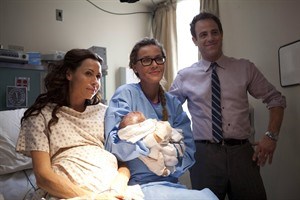
Minnie Driver, left, stars in the Lifetime movie “Return to Zero,” which makes its Canadian debut this Saturday. THE CANADIAN PRESS/ho-Karen Ballard
May 15, 2014 - 9:20 AM
TORONTO - The Lifetime movie "Return to Zero" airing this weekend is billed as the first feature film to have stillbirth as its central theme — a topic its Oscar-nominated star, Minnie Driver, acknowledges is heartbreaking to watch but feels must be brought out in the open.
"It's just the worst story in the world to try to tell. Nobody wants to talk about it or to hear about and yet you have to," she said in a telephone interview. "It's why Lifetime is so brave in putting this movie out, because no movie company would. We made it as an independent film, and people would see the film and say, 'This is one of the most powerful, beautiful things. We have no idea how you market this or who goes to see this film, it's just too sad.'
"But the idea that that sadness makes the story less relevant is not fair, and I'm so happy that it's going to be out there, because it is a hard, hard film but it's worth it. It's worth it to remind ourselves we can survive loss."
Making its Canadian debut on Saturday at 8 p.m. ET on Lifetime, "Return to Zero" stars Driver and Paul Adelstein as a married couple who learn weeks before the due date of their first child that the baby boy no longer has a heartbeat and will be a stillbirth, which is defined as the loss of a child after 20th week of pregnancy.
The story then follows the toll it takes on their relationship and the agonizing decisions they have to make — natural childbirth or cesarean section, cremation or burial, hold the baby or not?
Writer, director and producer Sean Hanish based the story on his own experience with his wife, and Driver admitted one of her "biggest fears" going into the project was that he wouldn't be able to separate his emotions during shooting.
"I was like, 'How is that going to work when you're watching the re-enactment of the birth of your child who's no longer living? How is that going to be?'" she said. "He was like, 'I know myself pretty well and I know much I want to tell the story, and I've been thinking about doing this for so many years that I think it's going to be all right.'
"And I just trusted him, I believed him ... and he was right. I don't know how he did it, but he did it."
Driver said she got to know Hanish well and met with his wife once as she tried to figure out how to tell their story with grace.
"It was the most challenging acting exercise I'd ever seen, that I'd ever been offered, that I'd ever had the opportunity to do," said Driver, who was up for an Oscar for her supporting role in “Good Will Hunting" and got Emmy and Golden Globe nominations for the series “The Riches."
"And for me that was always a go-to — if something is well-written and it's going to ask me to do something I have no idea how I'm going to do and I've actually never been confronted with."
In one of the most harrowing scenes, the couple takes a doctor's advice to hold the baby and pose for photos as a means to provide closure — something Driver said Hanish and his wife also did.
Driver admitted she was initially "kind of horrified (by) the idea," but as she spoke with experts and couples who'd been through the experience, she realized "it becomes an absolute lifeline for people to connect with the idea that their child had an existence."
"It helped give them a sense of passing, as it were, and the minute I connected with that it made a lot of sense," said the London native, who has a young son and is also a singer.
"A lot of my associates and people I know were like, 'God, that just sounds so ghoulish, to take a picture with a deceased baby,' and I was like, 'No, you've got to look at it completely differently. That's not a deceased baby. That is a loved member of a family and they don't have any opportunity to take pictures in a life. This is it.
"They have one moment to have a memory of that being.'"
Driver said Hanish didn't have enough money to finish the project, so he launched a Kickstarter campaign, "and 90 per cent of the people that contributed were families who had lost babies." Those families' names are listed in a crawl at the end of the film in what Driver calls a memorial of sorts.
Driver, who also sings on the film's soundtrack in a tune she and Adelstein wrote, said she's heard from families who've suffered a stillbirth and they've told her they're "so touched and feel such unity knowing that that story, which they feel is their story, is being told."
"I truly believe for them, it means that their children are being validated, the children that they lost ... that they meant something, that they were loved, they were relevant, they were part of this world even though it was so brief."
— Follow @VictoriaAhearn on Twitter.
News from © The Canadian Press, 2014